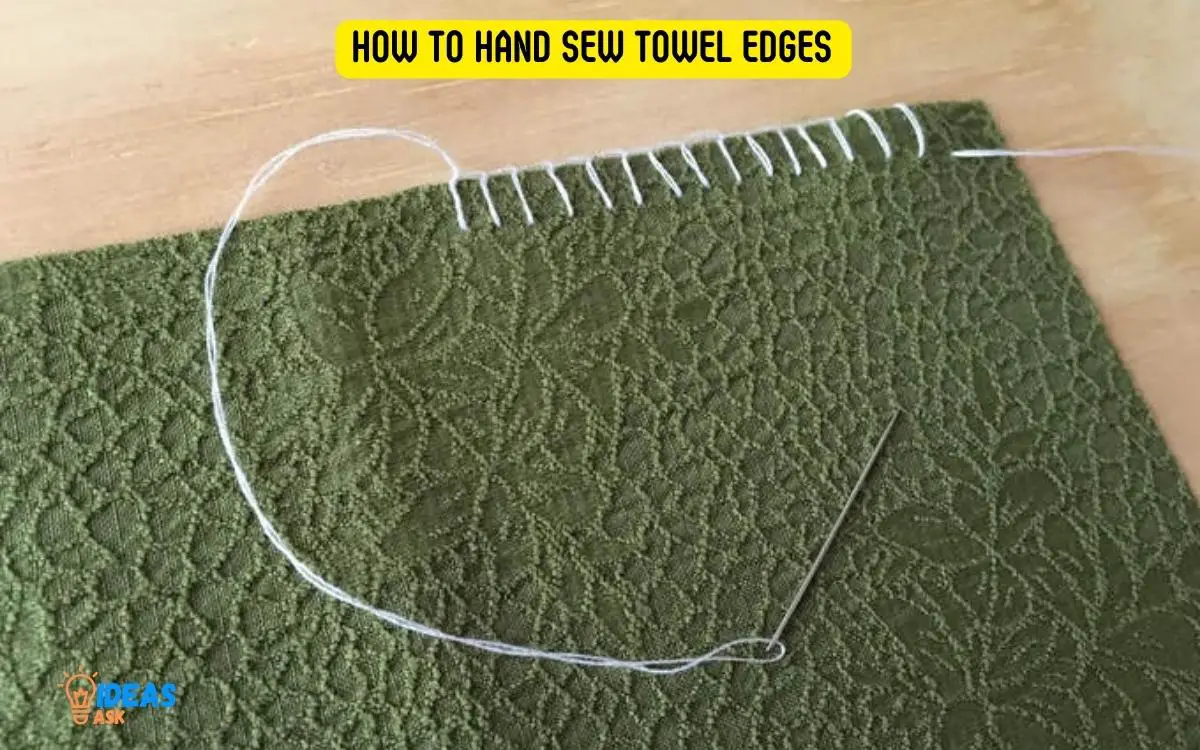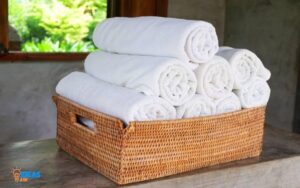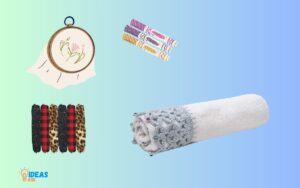How to Hand Sew Towel Edges? 4 Easy Steps!
To hand sew towel edges, you start by folding the towel edge by about half an inch and then another half an inch. You then thread your needle with a thread that matches the towel color and knot the thread at the end.
Next, you sew along the folded edge using the ‘running stitch’ technique. You finish by knotting the thread securely and cutting off any excess.
Hand sewing towel edges can be a great way to extend the life of your towels or add a decorative touch. This process involves folding over the edge of the towel to create a hem, then using a simple running stitch to secure it in place.
Running stitch is a basic sewing technique where the needle and thread ‘run’ along the fabric, going in and out in a straight line.
Hand sewing a towel’s edge is a simple and effective way to prolong its durability or add a stylish flair.
This process, which involves folding, sewing, and securing with a knot, can be easily accomplished even by novice sewers. It’s a great alternative to machine stitching, offering more control and the convenience of portability.

Key Takeaway
Understanding Hand Sewing Techniques
Learn how to hand sew towel edges with these easy-to-follow techniques. Enhance your sewing skills and create beautifully finished towels with this step-by-step guide.
Importance Of Hand Sewing For Towel Edges
Hand sewing is a valuable skill to have when it comes to creating durable and aesthetically pleasing towel edges.
While there are sewing machines available for this purpose, hand sewing allows for more control over the stitching process. It also gives an artisanal touch to the finished product.
The importance of hand sewing for towel edges can be summed up in the following points:
- Precision: Hand sewing enables you to achieve precise stitches along the towel edges. This level of accuracy ensures a neat and clean finish, enhancing the overall appearance of the towel.
- Durability: Hand stitching offers stronger and more resilient seams compared to machine stitching. The regular stitches created by hand sewing can withstand repeated use and washing, ensuring that the towel’s edges stay intact for longer.
- Personalization: Hand sewing allows you to add unique and personalized details to your towels. With different stitches and thread colors, you can showcase your creativity and make each towel truly one-of-a-kind.
- Repairability: If a machine-stitched towel edge becomes loose or damaged, it can be challenging to fix without specialized equipment. On the other hand, repairing a hand-stitched towel edge is relatively simple. You can easily undo the stitches and re-sew the edge without causing any further damage.
- Portability: Hand sewing is a portable craft. You can sew towel edges anywhere, even without access to electricity or a sewing machine. This makes it a convenient technique for on-the-go projects or while traveling.
Basic Tools And Materials Required
To get started with hand sewing towel edges, you will need the following basic tools and materials:
- Needles: Select a needle with a sharp point and an appropriate size for the type of fabric you are working with. A smaller needle size is suitable for light and medium-weight fabrics, while a larger needle size is preferable for heavy fabrics.
- Thread: Choose a thread that matches the color of your towel or complements its design. Cotton and polyester threads are commonly used for sewing towel edges due to their strength and durability.
- Scissors: Have a pair of sharp, fabric scissors dedicated solely for sewing purposes. These scissors will help you cut the thread and trim excess fabric accurately.
- Pins: Use pins to hold the towel edges in place before sewing. They keep the fabric aligned and prevent it from shifting during the sewing process.
- Thimble: A thimble protects your finger while pushing the needle through the fabric. It is particularly useful when sewing through multiple layers or thick fabrics.
- Iron: An iron is indispensable for pressing the towel edges before sewing. It helps create crisp edges and minimizes fabric puckering.
Introduction To Different Hand Sewing Stitches
There are various hand sewing stitches you can use to sew towel edges. Each stitch has its own purpose and gives a distinct look to the finished edge.
Here are some commonly used stitches:
- Running stitch: This stitch is created by taking the needle in and out of the fabric at regular intervals. It is quick and straightforward, ideal for securing the towel edges.
- Whipstitch: Whipstitch involves sewing over the raw edge of the fabric in a diagonal or vertical motion, creating interlocking stitches. It is a sturdy stitch that can prevent fraying and adds a decorative touch.
- Blanket stitch: Often used for decorative purposes, the blanket stitch creates a looped edge. It is formed by inserting the needle from the front side of the fabric and then pulling it through the loop created.
- Hemstitch: Hemstitch is commonly used for finishing hems and can also be applied to towel edges. It involves creating a row of evenly spaced stitches along the edge and then pulling the thread through the loops.
Remember to choose the stitch that best suits your aesthetic preference and the functionality required for your towel edges. Experimenting with different stitches can add an element of creativity to your sewing projects.
Step 1: Preparing The Towels For Sewing
Learn how to hand sew towel edges with these simple steps. From selecting the right thread to mastering the stitching technique, this guide will help you prepare your towels for sewing flawlessly.
Hand sewing towel edges is a simple and satisfying skill to master. With just a few basic materials and some patience, you can transform plain towels into beautifully finished pieces.
Before you start sewing, it’s important to prepare your towels properly to ensure a neat and professional result.
In this section, we will explore the essential steps for preparing the towels for sewing, including the selection of suitable fabrics and edging materials, measuring and marking the edging length, and washing and pressing the towels.
Selection Of Towel Fabrics And Edging Materials:
- Consider the type of towel fabric you are working with, such as cotton, terry cloth, or linen. Choose a fabric that is durable and easy to sew.
- Opt for 100% cotton towels for best results, as they are soft, absorbent, and ideal for hand sewing.
- When selecting edging materials, you have several options, including bias binding, fabric tape, or decorative trims. Choose a material that complements your towel fabric and desired style.
Measuring And Marking The Edging Length:
- Measure the perimeter of your towel using a fabric measuring tape. This will give you the total length of edging required.
- Add an extra inch or two to the measured length to account for any seams and allowances.
- Use tailor’s chalk or fabric marking pens to mark the edging length directly on the wrong side of the towel fabric. Make clear and accurate markings to ensure precision while sewing.
Washing And Pressing The Towels For Sewing:
- Before you begin sewing, it is essential to wash and press your towels. This step ensures that the fabric is clean, free from any sizing or finishes, and pre-shrunk.
- Launder the towels following the care instructions provided by the manufacturer. Use a mild detergent and avoid using fabric softeners, as they can leave residues that interfere with sewing.
- Once washed, gently press the towels using an iron set to the appropriate temperature for your fabric. Avoid using excessive heat, especially on delicate towels.
- Pressing the towels not only removes wrinkles but also helps in creating smooth and even edges, making it easier to sew.
By following these steps, you’ll be well-prepared and ready to sew your towel edges with precision and confidence. Take your time to ensure accuracy and enjoy the process of transforming simple towels into personalized and functional creations.
Happy sewing!
Step 2: Hand Sewing Techniques For Towel Edges
Learn essential hand sewing techniques for towel edges and add a personal touch to your bathroom decor. Discover step-by-step instructions to create neat and durable finishes for your towels.
Hand sewing towel edges can give your towels a polished and professional finish. Whether you’re looking to repair a frayed edge or add decorative stitching to a new towel, mastering the art of hand sewing is essential.
We will walk you through the step-by-step process of hand sewing towel edges, focusing on three primary techniques: the running stitch, blanket stitch, and whip stitch.
Let’s get started!
Choosing The Right Thread And Needle
When it comes to selecting the thread and needle for hand sewing towel edges, you want to ensure that you have the right tools for the job.
Here are some considerations to keep in mind:
- Thread: Opt for a strong and durable thread that matches the color of your towel. Cotton or polyester thread works well for most towels.
- Needle: Choose a needle with a sharp point that easily penetrates the fabric. The size of the needle should be appropriate for the thickness of your towel.
Securing The Thread And Starting The Sewing
Before you begin sewing the towel edges, it’s crucial to secure the thread and start your stitching correctly.
Follow these steps:
- Knot the Thread: Double the thread and tie a secure knot at the end, leaving a tail of about 2 inches.
- Insert the Needle: Insert the needle from the backside of the towel, bringing it up to the front where you want to start the stitching.
- Anchor the Thread: Take a small stitch on the backside of the towel, close to the starting point, to anchor the thread securely.
Running Stitch: Creating A Basic Edging
The running stitch is a simple yet effective technique for creating a basic edging on your towel.
Here’s how to do it:
- Bring the needle up from the backside of the towel, about 1/4 inch from the edge.
- Take a small stitch forward and then another stitch backward, keeping the stitches evenly spaced.
- Repeat this process, creating a straight line of stitches along the entire edge of the towel.
- End the stitching by anchoring the thread with a small knot on the backside of the towel.
Blanket Stitch: Adding Decorative Border
If you want to add a decorative border to your towel edge, the blanket stitch is a fantastic choice.
Here’s how to achieve this charming look:
- Start by bringing the needle up from the backside of the towel, about 1/4 inch from the edge.
- Take a small stitch forward and then bring the needle through the loop created by the previous stitch, forming a diagonal stitch.
- Repeat this process, creating evenly spaced diagonal stitches along the edge of the towel.
- Finish the blanket stitch by anchoring the thread with a small knot on the backside of the towel.
Whip Stitch: Finishing Touches For A Professional Look
The whip stitch is an excellent technique for adding a clean and professional finish to your towel edges.
Follow these steps:
- Begin by bringing the needle up from the backside of the towel, about 1/4 inch from the edge.
- Take a small stitch forward, and then bring the needle over the edge of the fabric and back through to the front, forming a diagonal stitch.
- Repeat this diagonal stitch pattern, making sure to keep the stitches evenly spaced and tight.
- To finish the whip stitch, anchor the thread with a small knot on the backside of the towel and trim any excess thread.
By exploring these three hand sewing techniques – the running stitch, blanket stitch, and whip stitch – you can elevate the look of your towels and give them a customized touch.
Remember to choose the right thread and needle, secure the thread properly, and practice your stitches for the best results.
Happy hand sewing!
Step 3: Troubleshooting And Tips For Success
Learn how to troubleshoot and find success when hand sewing towel edges with these helpful tips. Master the art of precise stitching and achieve professional-looking results with ease.
Sewing towel edges by hand can be a rewarding and creative experience. However, like any skill, it may take some practice to achieve perfection.
In this section, we will explore common issues that may arise when hand sewing towel edges and provide solutions to overcome them.
Additionally, we will discuss the importance of proper stitch tensioning and consistency, as well as adding embellishments and personalization to make your hand-sewn towels unique.
Lastly, we will offer guidance on cleaning and maintaining your hand-sewn towels to ensure their longevity.
Common Issues And Their Solutions:
- Looping threads: If you find that your threads are getting tangled and forming loops, try using a thread conditioner or beeswax to reduce friction. This will make it easier for the thread to glide through the fabric smoothly.
- Uneven stitch lengths: Inconsistency in stitch lengths can make your hand-sewn towel edges appear untidy. To maintain consistent stitch lengths, practice evenly spacing your stitches and keeping them the same size throughout the sewing process.
- Puckering fabric: If your fabric is puckering or gathering around the edges, it may be due to excessive tension on the thread. To alleviate this issue, adjust your stitch tension to a slightly looser setting. This will allow the fabric to lay flat and prevent unnecessary puckering.
Proper Stitch Tensioning And Consistency:
- Adjusting stitch tension: Experiment with different stitch tension settings on your sewing machine or adjust your hand-sewing technique to achieve the desired result. Remember to strike a balance between stitches that are not too tight and not too loose.
- Consistency is key: Consistent stitch tension and size throughout your hand-sewn towel edges are crucial for a professional finish. Aim for stitches that are evenly spaced and of the same length, which will create a visually pleasing and uniform look.
Adding Embellishments And Personalization:
- Embroidery: Enhance the beauty of your hand-sewn towel edges by incorporating embroidery stitches. From simple running stitches to intricate floral designs, embroidery can add a personalized touch to your towels.
- Appliqué: Another way to personalize your hand-sewn towels is by adding appliqué designs. Use fabric scraps or pre-made appliqué patches to create unique patterns or monograms. Secure the appliqué pieces with careful stitching or fabric glue.
- Trim and lace: For a more decorative look, consider attaching trim or lace to the edges of your towels. This can instantly elevate the overall appearance and give a touch of elegance to your hand-sewn creations.
Cleaning And Maintenance Of Hand-Sewn Towels:
- Gentle handwashing: To preserve the quality and longevity of your hand-sewn towels, opt for gentle handwashing with mild detergent. Avoid using bleach or strong chemicals that could damage the fabric or threads.
- Air drying: After washing, allow your hand-sewn towels to air dry naturally. This will prevent shrinkage and minimize the risk of warping or distortion.
- Ironing tips: When ironing your hand-sewn towels, always use a low to medium heat setting. Iron with caution to avoid pressing over delicate embellishments or damaging the stitches.
Remember, with practice and attention to detail, you can master the art of hand sewing towel edges.
Troubleshoot any issues that arise, maintain consistent stitch tension and size, add embellishments for a personal touch, and take proper care of your hand-sewn towels to ensure their beauty and durability for years to come.
Step 4: Showcasing Your Hand-Sewn Towels
Discover the art of hand-sewn towel edges and elevate your home decor. Learn how to showcase your craftsmanship with these simple techniques.
Styling And Displaying Hand-Sewn Towels
Hand-sewn towels are not just functional items but also beautiful pieces of art that can enhance the aesthetic appeal of any space.
Once you have completed the hand-sewing process, you may wonder how to showcase your creations in the best possible way.
Here are some tips on how to style and display your hand-sewn towels:
- In the bathroom: Hang your hand-sewn towels on a towel rack or hooks in your bathroom. Choose a color scheme that complements your bathroom decor. You can fold the towels neatly or roll them up for a more decorative look.
- In the kitchen: Display your hand-sewn tea towels in the kitchen by hanging them on hooks or draping them over the oven handle. Coordinate the colors and patterns of the towels with your kitchen theme for a cohesive look.
- As wall decor: Turn your hand-sewn towels into wall art by framing them. Select beautiful frames that match the style of your home and hang the framed towels in your living room, bedroom, or any other space where you want to add a touch of elegance.
- As table linens: Use your hand-sewn towels as table runners or placemats. Arrange them on your dining table during special occasions or everyday meals to impress your guests with your creativity and craftsmanship.
- As unique gifts: If you have hand-sewn towels that you don’t need for yourself, consider gifting them to friends and family. Package them in a creative and personalized way, such as tying them with a ribbon or placing them in a decorative box.
Creating A Handmade Towel Collection
Creating your own handmade towel collection can be a rewarding and fulfilling experience. Not only will you have a unique set of towels to use or display, but you will also have the satisfaction of knowing that you made them with your own hands.
Here are some steps to help you create your own handmade towel collection:
- Choose the fabric: Select high-quality fabric that is absorbent and durable. Cotton and linen are popular choices for hand-sewn towels due to their natural properties.
- Decide on the size and shape: Determine the dimensions and shape of your towels based on their intended use. Consider whether you want hand towels, bath towels, or kitchen towels, and measure accordingly.
- Select a design: Get creative with the design of your towels. You can choose to embroider a pattern, add decorative trim or lace, or even personalize them with monograms or names.
- Gather the necessary supplies: Stock up on sewing essentials such as needles, thread, scissors, and pins. Additionally, make sure you have any additional materials required for your chosen design, such as embroidery floss or lace.
- Get sewing: Follow a sewing pattern or create your own. Start by cutting the fabric into the desired size and shape, then sew the edges using a running stitch or another suitable sewing technique.
- Add finishing touches: Once the main sewing is complete, add any additional embellishments or details to enhance the towels’ appearance. This could include decorative stitching, fabric paint, or trims.
- Wash and iron: After finishing the towels, wash and iron them to give them a fresh and polished look. This will also help to remove any residual markings or wrinkles.
- Store and display: Find a suitable place to store and display your handmade towel collection. Consider using a linen closet, drawer, or open shelving to keep them organized and easily accessible.
Gift Ideas And Homemade Towel Sets
Handmade towel sets make for thoughtful and personalized gifts. They are not only practical but also showcase your creativity and craftsmanship.
Here are some gift ideas and homemade towel sets that you can consider:
- Kitchen essentials: Create a set of kitchen towels, oven mitts, and pot holders in coordinating colors and patterns. Package them together with a baking recipe book or a selection of gourmet spices for a complete kitchen-themed gift.
- Bath spa set: Hand-sew a set of luxurious bath towels, washcloths, and a matching bathrobe. Pair them with scented candles, bath salts, and a beautiful soap for a spa-inspired gift that will pamper the recipient.
- Baby shower bundle: Make a set of adorable and soft baby hooded towels, burp cloths, and washcloths. Wrap them up with baby skincare products or a plush toy for a delightful baby shower gift.
- Seasonal collections: Create themed towel sets for different seasons or holidays. For example, make a set of festive Christmas towels with holiday-themed patterns and colors. These can be a perfect hostess gift during the holiday season.
- Personalized monograms: Add a personal touch by embroidering monograms or names on the towels. This customization adds an extra special element to the gift, making it truly one-of-a-kind.
- Housewarming bundle: Assemble a set of hand-sewn towels, pot holders, and coasters as a housewarming gift. Include a recipe card or a bottle of wine to make the gift more complete and welcoming.
Hand-sewn towels are versatile and can be tailored to suit various occasions, seasons, and personal preferences.
Get creative, experiment with different fabrics, colors, and designs, and enjoy the process of creating your own unique towel collections and gift sets.
Conclusion
Mastering the art of hand sewing towel edges can bring a touch of elegance and personalization to your linens. By following these step-by-step instructions, you can create neat and durable edges that will withstand repeated use and washing.
Remember to choose high-quality materials and tools, and take your time to ensure precision and attention to detail.
Whether you’re a beginner or an experienced sewist, this technique is accessible and enjoyable, allowing you to add a handmade touch to your home.
Experiment with different stitches and decorative elements to create unique and personalized designs. With practice, your towel edges will become a source of pride and a testament to your sewing skills.
So go ahead, grab your needle and thread, and start transforming ordinary towels into beautiful works of art.






